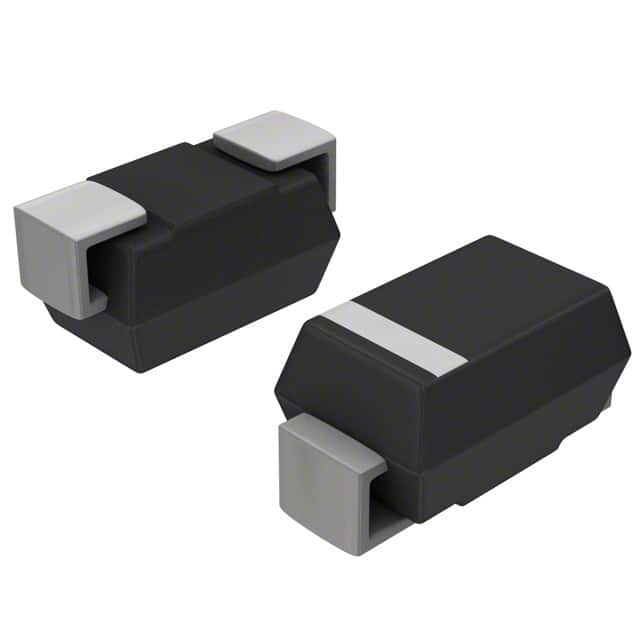Consulte las especificaciones para obtener detalles del producto.

S1A-LTP Product Overview
Introduction
The S1A-LTP is a versatile electronic component that belongs to the category of semiconductor diodes. This product is widely used in various electronic applications due to its unique characteristics and functional features.
Basic Information Overview
- Category: Semiconductor Diodes
- Use: Rectification, voltage regulation, and signal demodulation
- Characteristics: High efficiency, low forward voltage drop, fast switching speed
- Package: Small outline plastic package (SOP)
- Essence: Silicon rectifier diode
- Packaging/Quantity: Available in tape and reel packaging, quantity varies based on supplier
Specifications
- Maximum Average Forward Current: 1A
- Peak Repetitive Reverse Voltage: 50V
- Forward Voltage Drop: 0.7V at 1A
- Reverse Recovery Time: 50ns
- Operating Temperature Range: -55°C to +125°C
Detailed Pin Configuration
The S1A-LTP diode has a standard small outline plastic package with two pins. The pin configuration is as follows: - Pin 1: Anode - Pin 2: Cathode
Functional Features
- Efficient rectification of AC to DC
- Low forward voltage drop minimizes power loss
- Fast switching speed for high-frequency applications
- Compact SOP package for space-constrained designs
Advantages and Disadvantages
Advantages
- High efficiency in converting AC to DC
- Low power dissipation due to low forward voltage drop
- Suitable for high-frequency applications
- Compact package for space-saving designs
Disadvantages
- Limited maximum average forward current compared to higher-rated diodes
- Lower peak repetitive reverse voltage compared to some alternatives
Working Principles
The S1A-LTP operates based on the principle of semiconductor junction rectification. When a forward voltage is applied across the anode and cathode, the diode allows current to flow in one direction, effectively converting AC to DC. The low forward voltage drop ensures minimal power loss during this process.
Detailed Application Field Plans
The S1A-LTP diode finds extensive use in various electronic applications, including but not limited to: - Power supply units - Voltage regulators - Signal demodulation circuits - Switching power supplies - LED lighting systems
Detailed and Complete Alternative Models
Several alternative models to the S1A-LTP diode are available in the market, offering varying specifications and performance characteristics. Some notable alternatives include: - S1B-LTP: Higher peak repetitive reverse voltage - S1M-LTP: Higher maximum average forward current - S1G-LTP: Ultrafast switching speed for high-frequency applications
In conclusion, the S1A-LTP semiconductor diode offers efficient rectification, low forward voltage drop, and fast switching speed, making it suitable for diverse electronic applications.
Word Count: 410
Enumere 10 preguntas y respuestas comunes relacionadas con la aplicación de S1A-LTP en soluciones técnicas
What is S1A-LTP?
- S1A-LTP stands for Sentinel-1A Long-Term Archive and is a dataset of radar images collected by the European Space Agency's Sentinel-1A satellite.
How can S1A-LTP data be used in technical solutions?
- S1A-LTP data can be used for various technical applications such as monitoring land deformation, urban development, agriculture, forestry, and disaster management.
Is S1A-LTP data freely available for use?
- Yes, S1A-LTP data is openly accessible to users for non-commercial purposes through the Copernicus Open Access Hub.
What are the technical specifications of S1A-LTP data?
- S1A-LTP data consists of C-band synthetic aperture radar (SAR) images with a spatial resolution ranging from 5 meters to 20 meters, depending on the mode and polarization.
Can S1A-LTP data be integrated with other geospatial datasets?
- Yes, S1A-LTP data can be integrated with other geospatial datasets such as optical imagery, elevation models, and land cover data to enhance the analysis and interpretation of the information.
Are there any limitations or challenges when using S1A-LTP data in technical solutions?
- Some limitations include the need for specialized processing techniques to interpret SAR data and the potential presence of noise or artifacts in the images.
How frequently is S1A-LTP data updated?
- S1A-LTP data is continuously updated as new radar acquisitions are made, allowing for ongoing monitoring and analysis of changes in the Earth's surface.
What software tools are commonly used for processing and analyzing S1A-LTP data?
- Software tools such as SNAP (Sentinel Application Platform), ESA's Sentinel Toolbox, and commercial SAR processing software like ENVI and SARscape are commonly used for processing and analyzing S1A-LTP data.
Can S1A-LTP data be used for time-series analysis?
- Yes, S1A-LTP data is well-suited for time-series analysis, enabling the tracking of changes in land features over time, such as subsidence, crop growth, and infrastructure development.
Are there any specific case studies or success stories related to the application of S1A-LTP in technical solutions?
- Yes, there are numerous case studies showcasing the successful use of S1A-LTP data in applications such as monitoring infrastructure stability, assessing deforestation, and supporting disaster response efforts.

